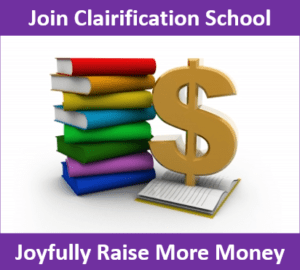
There is nothing so useless as doing efficiently that which should not be done at all. –Peter Drucker
Do you think of your nonprofit event as a “fund raiser” or a “donor cultivation experience?”
The simple, obvious answer, of course, is that a good event is both.
In practice, however, successful event fundraising – galas and sport events and auctions that are worth the effort — is not this simple.
So let me ask this question another way:
What is your number one goal with your special event?
Think about this carefully for a moment. There can be a lot of reasons, good and not-so-good, for embarking on this admittedly resource-intensive strategy. Do your ends justify your means?
If you had to give ONE reason you’re putting your event on, what would it be?
I’ll bet you’re thinking one or more of the following:
- To raise X dollars
- To raise awareness
- To bring in new prospective donors
- To upgrade existing donors
- To bring community together
All laudable goals. But do they get to the heart of why you’re planning this particular event, as opposed to choosing another strategy? A strategy that might be less labor intensive and more cost effective?
Hmmn…
Let’s look at it another way:
If you don’t hold this event this year, what will you lose?
This is where it gets interesting.
When I ask folks this question, I tend to get these types of answers:
- We’ll lose $XXXXX.
- We’ll lose some of our board and volunteers by making them angry.
- We’ll lose individual donors who only give to the event.
- We’ll lose corporate sponsors who only give to the event.
- We’ll miss out on the annual article our local paper writes announcing the event.
- We’ll lose an opportunity for current board and donors to invite their friends and introduce them to our organization.
- We’ll lose an opportunity to honor major supporters.
It’s understandable folks don’t want to lose these benefits. Yet sometimes there are other, even better ways to achieve them.
Which is why it’s good to look at goals and strategies yet another way:
If you don’t hold this event this year, what will you gain?
I love considering what I might gain in having the courage to drop an event.
Because there’s always a lost opportunity cost, right? Given limited resources, you can’t do everything!
Something to consider: Ssometimes it makes a great deal of sense to slide an event off your plate to make room for a new strategy that might more efficiently and effectively meet your goals (e.g., I often advocate three alternative donor retention and upgrade strategies to my clients if they don’t currently have them solidly in place: (1) a monthly giving program; (2) a DIY P2P fundraising program, and/or (3) a program to promote giving from Donor Advised Funds).
Here’s the problem – and it’s a very human one: We’re wired to avoid loss more than to seek gain. Colloquially, this is called FOMO (fear of missing out). Commonly, nonprofits fear the wrath of vocal volunteers who don’t want to see their beloved event go. They fear losing the dollars they’ve come to count on from their event.
It sounds sensible, until you do the math. Sadly, many nonprofits aren’t very good at math. Because everyone approaches the numbers from separate perspectives rather than holistically.
- The fundraiser, E.D. and board look at the numbers and say: “Woohoo! We brought in $250,000 in ticket sales, raffle and auction purchases!”
- The CFO and treasurer look at the numbers and say: “Wait a minute. Expenses show we netted only $100,000, and that doesn’t take into account staff salaries. Net/net, we ended up in the red.”
- The outside consultant looks at the numbers and says: “Your cost per dollar raised was through the roof, and you also did this at the expense of other more cost-effective opportunities you could have been pursuing.”
Some events simply should not be done at all. You need to honestly evaluate why you’re doing one, and what you’re getting as a return on your investment.
But don’t think I’m advocating against events entirely. Not at all.
Special events have their place; you just need to know what it is.
I’m advocating you know (and everyone agrees on) your goals, you understand your costs and you get clarity on your objectives.
What all this math and number crunching misses is the human element of events. In other words, the wonderful way events can make your donors feel.
There is a tremendous amount of goodwill that can be gained from events.
In fact, there may be no more effective way to cultivate some major donor prospects than through an event.
TRUE STORY: I ran a Gala dinner event for 22 years. When I began, I thought it was primarily a fund raiser. A lot of supporters became major donors through becoming event sponsors. It somehow didn’t occur to us that perhaps they might continue to give at this level as annual donors WITHOUT the event. But then one year we asked them to – and they did! And they came to the event too! But we noticed people were out the door by 9:30 or 10:00 p.m. They didn’t seem to be LOVING the event. So we surveyed folks and learned there were a large group who would prefer to move the event from a Sunday to a Saturday evening. And they wanted a livelier dance band. They wanted to do good and FEEL good at the same time – they wanted more fun! So we made those changes, and attracted more people. Then we added an auction to raise more money. When it didn’t raise as much as we’d hoped, we considered axing it. But… we learned that our guests had really enjoyed it. They considered it part of the entertainment. They wanted to come again, and they wanted to invite their friends. This made us consider even more what our guests might enjoy. We continued to add little touches to delight folks. And we made our honoree program more about the impact our donors were making possible. We brought tears to their eyes, lumps to their throats and smiles to their faces. It was impossible to leave without feeling the evening had been well spent. And, most importantly, the majority of attendees increased their giving the following year [Note: It wasn’t just because of the event itself; it was also because of the strategic follow-up we put in place because we understood the primary purpose of the event was priming the pump for future cultivation].
The best reason to hold an event is to make people feel.
It’s up to you to decide what you want folks to feel (angry, sad, disturbed, surprised, delighted, uplifted, renewed, happy, hopeful, or some combination thereof), but above all else you want them to feel part of something larger than themselves.
You want folks to feel positively connected and attached. To your cause. Your community. Your family.
A community takes care of its members. I had a boss who used to say “Without caring, you don’t have a community; you just have a zip code.” This means you take care of your event participants, then they’ll take care of you.
In Part 2 we’ll take a look at some of the strategies you can use to assure your event lives up to, and surpasses, your donors’ expectations.
Your comments are very welcome!
 You may also enjoy:
You may also enjoy:
- Fundraising Silent Auctions: The Good, the Bad, the Ugly, the Easy
- Fundraising Silent Auctions: It’s the Items, Stupid
Please make sure you enroll in Clairification School to get access to all my articles and other content for a full 12 months. My goal is to help nonprofits of all shapes and sizes, and I understand not everyone has a budget for conferences or coaching. Clairification School is here to meet your needs. Feel free to let me know what topics you’d like to hear more about!





Great article. My takeaway is to – focus on what you want your supporters to feel, then do it well.
And, when we sincerely give from our heart, and generously, we receive from their heart, and generously.
Thanks for the another thoughtful post. “Thoughtful” is really it’s overarching message- think about what you’re doing and why.